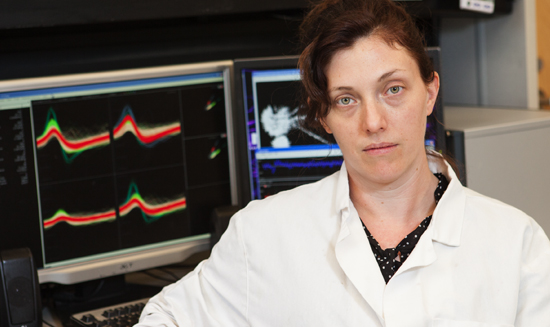




Amy Griffin is studying the mechanisms in the brain that are responsible for working memory. Problems with working memory are common in schizophrenia and anxiety disorders.
Not so long ago, scientists studying how learning occurs were looking to identify the region of the brain responsible for that process, says Amy Griffin, assistant professor of psychology at UD. Today, the research has a different focus.
"It's not any one single region of the brain that's known to be responsible for complex learning, Griffin says. "The regions all do their different things, but the key is that they have to communicate and interact for learning to occur."
Her own research, which is among the projects being supported by the new Delaware Center for Neuroscience Research, focuses on the mechanisms in the brain that are responsible for what's called working memory. Problems with working memory, Griffin says, are common features of a variety of psychiatric disorders including schizophrenia and general anxiety disorder.
On a more everyday level, it's also "the kind of memory that fails when you walk into a room and forget why you came there," Griffin says.
She is specifically investigating the structure that runs from the hippocampus, the portion of the brain responsible for memory, to the prefrontal cortex, responsible for executive function, which includes such cognitive abilities as problem-solving, planning and abstract thinking.
"These two key structures, the hippocampus and the prefrontal cortex, need to work together for working memory to occur," she says. The prefrontal cortex is thought to receive direct projections from the hippocampus and then to use retrieved memories to construct a plan of action that enables a task to be performed.
Griffin uses a rat model to study the interaction between the two brain regions and its effect on working memory. Rats are trained to navigate a maze in which they must remember which way to turn and then use executive function to plan the route they will take. Once the animals are trained to do the task well, the relay between the hippocampus and prefrontal cortex is inactivated, and their success rate drops to 50–60 percent, or about what could be explained by chance.
In addition to giving the rats the test of their working memory, Griffin simultaneously studies the mechanisms of how the brain works in the process. She says her research interests for some time have been in multi-regional brain interactions, an area of study that is increasingly the subject of neuroscience work.
Eventually, she says, "Understanding the nature of complex cognitive processes such as learning and memory will have important implications, including the possible treatment of neurological disorders such as Alzheimer's disease, attention deficit hyperactivity disorder and schizophrenia."